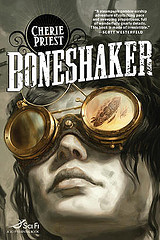I’m tempted to make a dorky joke to the tune of [:: tap tap ::] “Is this thing on?” But I’ll restrain myself. Sort of. The truth of it is, I always feel a little weird when guest-blogging—much less in front of an audience the size of this one. I’m always afraid I’ll say something to embarrass my host, or reveal a gaping black hole of personal ignorance.
But Tor.com was kind enough to invite me, here on the cusp of my fifth novel from Tor Books, Boneshaker. So here I go, game and happy to give it a whirl.
As a matter of general introduction—and to get the obligatory self-promotion out of the way—I figured I’d natter on a bit about this new book and how it came to be; and thereby warn you about what you might expect from me over the next few weeks.
To lay it down personal-ad style: I’m a history dork and an alternate-history nerd. I like to ask “what if?” and give honest consideration to wacky conspiracy theories. I’m fond of pirates, clandestine societies, adventure pulp, mad scientists, and hats. I love short sprints on the beach and overly elaborate goggles. I brake for zombies. But then I rev the engine and hit the gas.
Shall we then?
Pick a genre book—any genre, any book—and the cover will probably provide a satisfactory shorthand for where it ought to be shelved. Wizards, elves, and knights? You’ve got yourself a fantasy novel. Fangs and a matte black background? Horror. And so forth.
But a couple of years ago when I began working on Boneshaker, I couldn’t name many meaningful signifiers that screamed out “steampunk.” Oh there were goggles, sure—but no one seemed to have a good explanation for what the goggles were for apart from leaving a sweaty crease above your eyebrows. The delightful preponderance of Victorian garb was striking and fun, but the gas masks left me scratching my head. Gears made sense, even on top hats, I supposed. Watch chains were shiny, so, you know. Cool.
However, the odd goggle-wearing, retro-dressing, hat-decorating pocket-watch toter might be mistaken for a goth at a glance. In fact, my friend Jess Nevins once repeated that he’d heard steampunk is what happens when goths discover brown. While this assessment oversimplifies the matter, it’d be silly to pretend that there isn’t a great deal of overlap between the two scenes.
So. As an aging quasi-goth with a deep-seated interest in steampunk, I wanted to take an honest stab at the genre—giving it legs, or at least giving its stranger elements a literary excuse to complement the fashion imperative.
Boneshaker began this way, as an idle exercise—a noodling experiment. But like so many projects, I had no idea when I began exactly how far it would take me … or how weird it would get.
I started out with only a few concrete demands: I wanted this story to be American, and not London gaslamp; I wanted to write about people, not about a world-setting; but I needed for the people to by symptomatic of that world-setting.
Also, I wanted zombies.
The world came first. Nineteenth-century America was strange enough without any interference from yours truly, but I imagined it as if the Civil War had lingered—and the west was not incorporated, or organized. I thought of Texas, and how it might have remained a republic. I wondered how the Confederacy could’ve held on, and how the Union would’ve restructured, and what the war would’ve looked like decades down the line—when most of the men who’d started fighting it were dead, and their sons were fighting over grievances they were too young to remember firsthand.
Piece by piece the Clockwork Century came together, and on that foundation I found people with stories to tell. I found former slaves and air pirates, criminal overlords and Native American princesses. I found a deranged scientist or two. And eventually I found Briar Wilkes—the widow of a madman, mother of a runaway, and daughter of a dead folk hero.
Boneshaker is her story. And like steampunk itself, Boneshaker is about rummaging through the wreckage of the past and finding something worth salvaging, and maybe even worth celebrating. So if you take a chance on my new book, I do hope you enjoy it. If it’s half as much fun to read as it was to write, I’ll consider the whole noodling experiment a grand success.
Cherie Priest is the author of seven novels from Tor books and Subterranean Press, including the award-winning Eden Moore series, Dreadful Skin, and Fathom. Her most recent book, Boneshaker, was released on September 29th by Tor.










